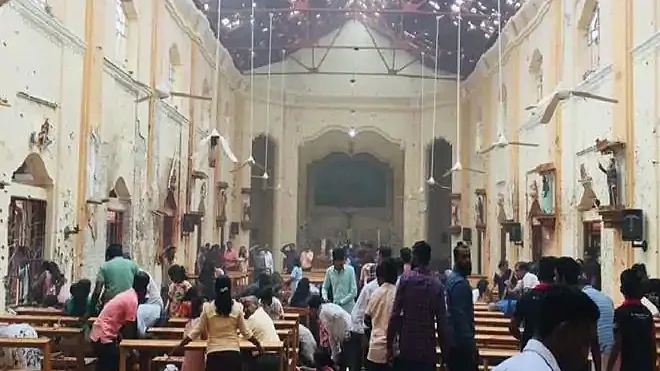Sri Lanka govt split on anti-terror stance; uncertainty to continue till next general elections in January
Despite receiving advance intelligence from New Delhi, those entrusted with the responsibility of security in Sri Lanka, did nothing to foil the terror attack that took place on Easter Sunday

What is most sinister about the serial blasts in Sri Lanka on Easter Sunday is their subterranean ramifications. There is not an iota of doubt that the Colombo authorities had been informed by New Delhi that the ISIS was planning a terror attack on big hotels and the Indian High Commission in Colombo.
Despite this advance intelligence, those entrusted with the responsibility of security in that country, did nothing to foil it. They were guilty of dereliction of duty. The obvious question is, why did they ignore the specific warnings and sat over them? The result was that at least 359 innocent men, women and children lost their lives in a gruesome attack.
Indian Intelligence agencies had given the Sri Lankan authorities specific information about the impending attacks. The first warning from India came on April 4, full seventeen days before the attacks. The warning was then repeated two days and then again just two hours before the attack. Still no action was taken. The Government remained quiescently inert and inactive. Why?
The answer lies in the deep division in the Sri Lanka Government. Two comments made separately by Prime Minister Ranil Wickremesinghe and President Maithripala Sirisena bring out the state of affairs. The Prime Minister told a news agency: “India had shared intelligence but there has been a lapse on how we acted on that. Intelligence was not conveyed down the line.” This means that there was no lateral flow of information between the intelligence and security agencies.
On the other hand, President Sirisena said he was not aware of the advance warnings. If he had been, he would have taken appropriate measures. Clearly, the Prime Minister did not share with his President the intelligence reports he had received. This shows the rift between the Prime Minister and the President.
The rift – and the crisis following it – occurred last year when Sirisena “dismissed” Wickremesinghe from the office of prime minister and “appointed” former President Rajapaksa, his one-time enemy, as prime minister.
The President’s order was challenged in the Supreme Court which held the President’s order unconstitutional and set it aside. Wickremesinghe was reinstated as Prime Minister. Since then the relationship between the Prime Minister and the President has been anything but cordial. One result of this is the failure to prevent the terror attacks despite advance Intelligence reports.
That apart, there seems to have been some complicity on the part of some top officials of Sri Lanka. A Sri Lankan minister, Lakshman Kiriella, has gone on record that some senior officials had deliberately withheld intelligence reports about a possible terror attack.
According to him, these officials “hid” the intelligence report purposefully. President Sirisena has now asked for the resignations of the Defence Secretary and the police chief. It thus becomes incumbent on the Sirisena government to unearth the larger conspiracy, identify the “insiders” who collaborated with the terrorists and betrayed the trust reposed in them and why they did not act.
The National Towheed Jamat (NTJ), a little known terror group, is believed to have been responsible for the attacks. But many believe that such a massive terror operation across the country, from Batticaloa in the east to Colombo on the west could not have been carried out by an organization which has only a hundred to a hundred and fifty members. It is suspected that a powerful terrorist organization abroad had helped the NTJ.
It is in this context that the ISIS claim that the blasts were their handiwork has to be viewed. Its involvement has not been proved so far. One man, Zahran Hashim, is believed to have been the mastermind behind the attacks. A video released by the ISIS shows a group of masked men pledging allegiance to the terror group. Only one man wears no mask. He has been identified as Zahran. He is suspected to be one of the suicide bombers.
The highly influential Buddhist clergy is hostile to both Christians and Muslims. The Bodu Bala Sena, a Right-wing Buddhist nationalist organization, has attacked churches and once it killed a pastor. In June, 2014, there were large-scale anti-Muslim riots in the country in which four persons were killed and eighty injured. Hundreds were rendered homelesss and nearly ten thousand people (some eight thousand Muslims and two thousand Sinhalese) were displaced.
The Bodu Bala Sena was blamed for inciting the riots but it denied responsibility. The composition of Sri Lanka’s 22 million population is: Buddhists 70%; Hindus 12.6%, Muslims 9.7% and Christians 7.6%.
The situation in Sri Lanka is tense. The rift within the Government is now wide open. It has immobilized the administrative machinery as seen in the failure to prevent the terror attacks. There is no possibility of a rapprochement between the President and the Prime Minister any time soon.
The next general elections for Sri Lanka are slated for January, 2020. Which means that the Government will remain crisis-ridden at least for the next eight months. The alignment of political forces which will emerge after the elections is expected to resolve the ongoing crisis.
Follow us on: Facebook, Twitter, Google News, Instagram
Join our official telegram channel (@nationalherald) and stay updated with the latest headlines
